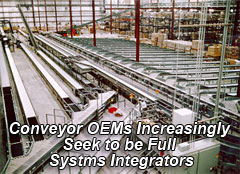Why would manufacturers pursue SI strategies? There are several reasons.
? MHA manufacturers, like most suppliers, would like to be closer to its end customers and to add more value in each project.
? US manufacturer may feel the need to have an offering that competes effectively with the growing ranks of European providers, which have been at this game for awhile.
? Manufacturers recognize that end customers want an “unbiased” equipment selection, or at least to have access to equipment from more than one vendor.
? In some cases, especially with the European vendors, vendors are willing to provide some level of guarantee around system throughput – but only if they own it all.
No one should expect, however, that a conveyor manufacturer acting as SI is going to use a competitor’s conveyor system or other basic equipment as part of the total system. Nevertheless, if an equipment OEM is going to position itself as a true SI, it absolutely must be willing to look at technologies and equipment that it does not currently manufacture as part of the total system design.
This need for broad system design and integration is especially coming to the fore in terms of Automated Case Picking (ACP), where there exists a wide variety of solutions and equipment providers, each appropriate to different DC operating and SKU parameters and for which no one manufacturer will produce all the solution types any time soon.
As a result of all this, users will have another important alternative for SI provider, in addition to the “independent,” non-manufacturing SIs that have dominated the systems integration market to date in North America.
User Recommendations
Users should be rightly concerned that equipment OEMs will not, as advertised, bring truly objective design and equipment selection to the project.
 However, as briefly mentioned above, it is generally not true that even “independent” SIs are equipment or manufacturing neutral. The tendency even there is to go with vendors with which the SI has a relationship, price discounts, and application experience. However, as briefly mentioned above, it is generally not true that even “independent” SIs are equipment or manufacturing neutral. The tendency even there is to go with vendors with which the SI has a relationship, price discounts, and application experience.
That said, clearly to us, the most appropriate use of OEMs as system integrator for broad DC system design and implementation (beyond more narrow sub-system deployment) is when there has been a long standing relationship with a given manufacturer, leading to a high level of trust between the companies and specific individuals at the MHA company. In addition to simply providing the right foundation for this level of relationship, this level of existing partnership will lessen the degree of “buyer’s remorse” after the project that can often occur from choosing the SI path.
Second, we believe that over the next few years, we will see MHA users demanding more guarantees from system providers about system performance, productivity, and throughput than is typically the case today.
To make such guarantees, it is simply logical that system providers can only do so if they have nearly complete control of system design (within customer constraints) and all aspects of hardware and software selection and implementation.
We believe it is important that equipment OEMs be able to demonstrate not only project success where they have acted as full SIs, but also show examples of where they have successfully selected and implemented MHA systems in which equipment or sub-systems they did not manufacture were used as part of the total design.
What is your take on equipment manufacturers as systems integrators for large, complex projects? Any experience pro or con? Do you expect to see more of this in the future? Let us know your thoughts at the Feedback button below.
SCDigest is Twittering!
Follow us now at https://twitter.com/scdigest |